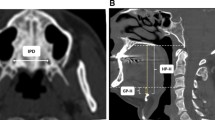Abstract
Purpose
To identify MRI-based quantitative craniofacial variables linked to airways narrowing and obstructive sleep apnea (OSA) development in children with achondroplasia.
Methods
We evaluated skull base and midface MRI in two cohorts of children affected by achondroplasia, with (group 1) or without OSA (group 2). 3DFSPGR-T1weighted images were used to assess airways volume (nasopharynx, oropharynx, and laryngopharynx), jugular foramina (JF) and hypoglossal foramina (HF) areas, foramen magnum area, cervical cord area, and maxillary retrusion (SNA angle).
Results
Nineteen out of 27 children with achondroplasia exhibited different degrees of obstructive respiratory impairment (n.4 mild, n.8 moderate, n.7 severe), while 8 children did not show OSA. Each group was compared with age-matched controls without neuroimaging abnormalities. Both groups showed reduced nasopharynx volume, JF areas, and SNA angle, while group 1 showed also reduced oropharynx volume, ratio of FM/cervical cord areas, and HF areas (p < 0.05). A positive correlation between nasopharynx volume and SNA angle was found in both groups, while a positive correlation among upper airways volume, JF and HF areas was found only in group 1. No correlation between upper airways volume and OSA severity was found.
Conclusion
In children with achondroplasia, multifaced craniofacial abnormalities contribute to airways volume reduction predisposing to sleep disordered breathing. MRI-based quantitative assessment allows the appraisal of craniofacial variables linked to the development of sleep-disordered breathing such as FM stenosis, jugular and hypoglossal foramina stenosis, and retruded maxillary position and may be a valuable tool for clinical surveillance.


Similar content being viewed by others
References
Booth KL, Levy DA, White DR et al (2020) Management of obstructive sleep apnea in children with achondroplasia: outcomes of surgical interventions. Int J Pediatr Otorhinolaryngol 138:110332
Susarla SM, Mundinger GS, Kapadia H et al (2017) Subcranial and orthognathic surgery for obstructive sleep apnea in achondroplasia. J Craniomaxillofac Surg 45:2028–2034
Afsharpaiman S, Sillence DO, Sheikhvatan M et al (2011) Respiratory events and obstructive sleep apnea in children with achondroplasia: investigation and treatment outcomes. Sleep Breath 15:755–761
Okenfuss E, Moghaddam B, Avins AL (2020) Natural history of achondroplasia: a retrospective review of longitudinal clinical data. Am J Med Genet A 182:2540–2551
Tenconi R, Khirani S, Amaddeo A et al (2017) Sleep-disordered breathing and its management in children with achondroplasia. Am J Med Genet A 173:868–878
Tasker RC, Dundas I, Laverty A et al (1998) Distinct patterns of respiratory difficulty in young children with achondroplasia: a clinical, sleep, and lung function study. Arch Dis Child 79:99–108
Onodera K, Niikuni N, Chigono T et al (2006) Sleep disordered breathing in children with achondroplasia. Part 2. Relationship with craniofacial and airway morphology. Int J Pediatr Otorhinolaryngol 70:453–461
Cocca A, Thompson D, Rahim Z et al (2020) Centrally mediated obstructive apnoea and restenosis of the foramen magnum in an infant with achondroplasia. Br J Neurosurg 1–4
Roland PS, Rosenfeld RM, Brooks LJ et al (2011) Clinical practice guideline: Polysomnography for sleep-disordered breathing prior to tonsillectomy in children. Otolaryngol Head Neck Surg 145:S1-15
Brodsky L, Moore L, Stanievich JF (1987) A comparison of tonsillar size and oropharyngeal dimensions in children with obstructive adenotonsillar hypertrophy. Int J Pediatr Otorhinolaryngol 13:149–156
Calandrelli R, Pilato F, Massimi L et al (2018) Quantitative evaluation of facial hypoplasia and airway obstruction in infants with syndromic craniosynostosis: relationship with skull base and splanchnocranium sutural pattern. Neuroradiology 60:517–528
Zaffanello M, Piacentini G, Sacchetto L et al (2018) Sleep-disordered breathing in children with rare skeletal disorders: a survey of clinical records. Med Princ Pract 27:451–458
Sano M, Takahashi N, Nagasaki K et al (2018) Polysomnography as an indicator for cervicomedullary decompression to treat foramen magnum stenosis in achondroplasia. Childs Nerv Syst 34:2275–2281
Calandrelli R, Panfili M, D’Apolito G et al (2017) Quantitative approach to the posterior cranial fossa and craniocervical junction in asymptomatic children with achondroplasia. Neuroradiology 59:1031–1041
Sarioglu FC, Sarioglu O, Guleryuz H (2020) Neuroimaging and calvarial findings in achondroplasia. Pediatr Radiol 50:1669–1679
Al-Saleem A, Al-Jobair A (2010) Achondroplasia: Craniofacial manifestations and considerations in dental management. Saudi Dent J 22:195–199
Langford RJ, Sgouros S, Natarajan K et al (2003) Maxillary volume growth in childhood. Plast Reconstr Surg 111:1591–1597
Author information
Authors and Affiliations
Corresponding author
Ethics declarations
Ethics approval
We declare that all procedures performed in studies involving human participants were in accordance with the ethical standards of the institutional and/or national research committee and with the 1964 Helsinki declaration and its later amendments or comparable ethical standards. For this type of study, formal consent is not required.
Informed consent
Informed consent was obtained from all individual participants included in the study.
Conflict of interest
Rosalinda Calandrelli declares that she has no conflict of interest. Fabio Pilato declares that he has no conflict of interest. Gabriella D’Apolito declares that she has no conflict of interest. Lorenzo Tenore declares that he has no conflict of interest. Roberta Onesimo declares that she has no conflict of interest. Chiara Leoni declares that she has no conflict of interest. Giuseppe Zampino declares that he has no conflict of interest. Cesare Colosimo declares that he is scientific consultant for Bracco Diagnostics Inc. and Bayer HealthCare.
Additional information
Publisher's Note
Springer Nature remains neutral with regard to jurisdictional claims in published maps and institutional affiliations.
Rights and permissions
About this article
Cite this article
Calandrelli, R., Pilato, F., D’Apolito, G. et al. Airways and craniofacial assessment in children affected by achondroplasia with and without sleep-disordered breathing: quantitative magnetic resonance study. Childs Nerv Syst 38, 1147–1154 (2022). https://doi.org/10.1007/s00381-022-05484-w
Received:
Accepted:
Published:
Issue Date:
DOI: https://doi.org/10.1007/s00381-022-05484-w




